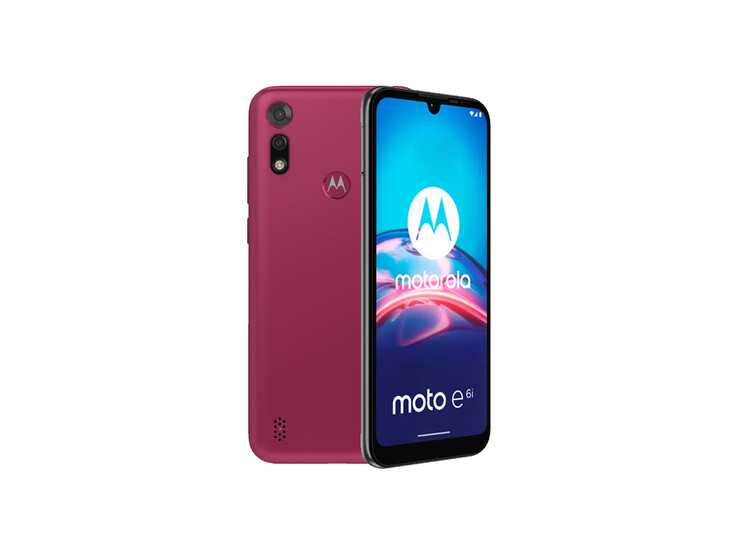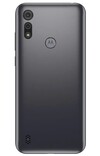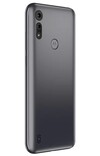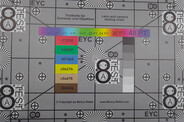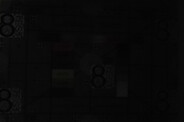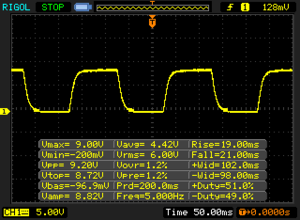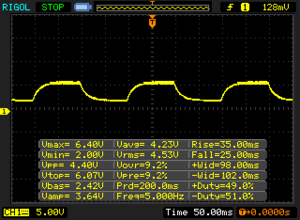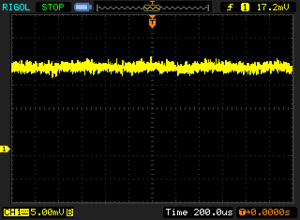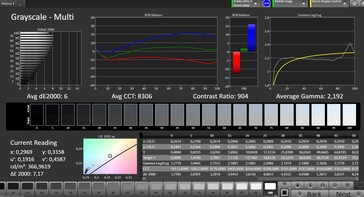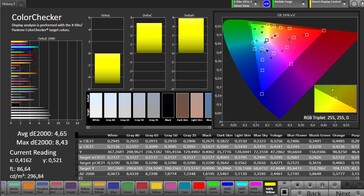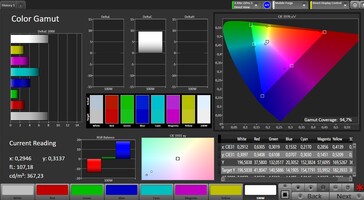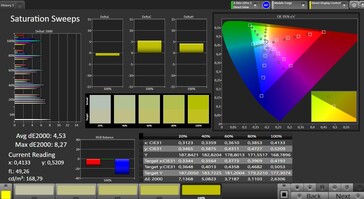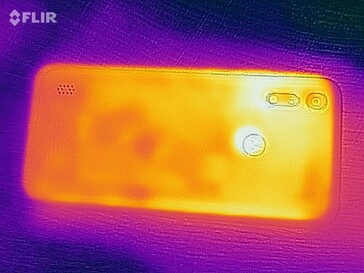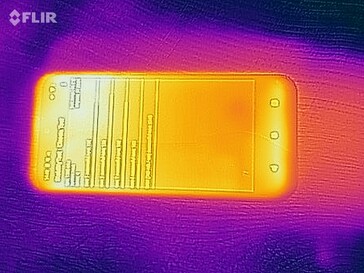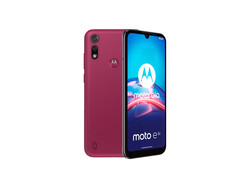Motorola Moto E6i smartphone review - Discreet and affordable Moto phone
Possible competitors in comparison
Rating | Rating Version | Date | Model | Weight | Drive | Size | Resolution | Price from |
|---|---|---|---|---|---|---|---|---|
| 73.3 % v7 (old) | v7 (old) | 05 / 2021 | Motorola Moto E6i SC9863A, GE8322 / IMG8322 | 160 g | 32 GB eMMC Flash | 6.10" | 1560x720 | |
| 74.8 % v7 (old) | v7 (old) | 05 / 2020 | Motorola Moto E6s Helio P22 MT6762, PowerVR GE8320 | 160 g | 32 GB eMMC Flash | 6.10" | 1560x720 | |
| 76 % v7 (old) | v7 (old) | 12 / 2020 | Nokia 3.4 SD 460, Adreno 610 | 180 g | 64 GB eMMC Flash | 6.39" | 1560x720 | |
| 75.3 % v7 (old) | v7 (old) | 04 / 2021 | Xiaomi Redmi 9AT Helio G25, PowerVR GE8320 | 194 g | 32 GB eMMC Flash | 6.53" | 1600x720 |
Case, features and operation - Handy smartphone
The dimensions and weight of Motorola's Moto E6i actually correspond exactly to those of the Moto E6s from last year. Thus, the smartphone is again handy and light, and it is especially better suited for smaller hands than some current smartphones. The casing looks a bit simpler than in the Moto E6s. There is no longer a color gradient, but a discreet matte back in gray or rosé
In contrast to the predecessor, you also have to live with a somewhat weaker chassis this time: Pressure quickly gets through to the screen. The overall quality impression is only average, but OK for the price range.
Once again, you have to make do with Wi-Fi 4, but that is not unusual for a phone for less than 100 Euros. At the same time, the Moto E6i proves to be slightly faster overall in our Wi-Fi test with the reference router Netgear Nighthawk AX12, but still in the lower range of the comparison devices with only acceptable speeds.
NFC is not available, so users who want to use mobile payment services will have to invest more money in their smartphone. The storage capacity is scarce, but on par with the class.
A fingerprint sensor is found on the back, which unlocks the screen quite reliably after a short delay. The user will have to cope with minor stutters in everyday use.
| Cross Platform Disk Test (CPDT) | |
| SDCard Sequential Read 0.5 GB | |
| Motorola Moto E6i | |
| Average of class Smartphone (43.4 - 81.5, n=67, last 2 years) | |
| SDCard Sequential Write 0.5 GB | |
| Average of class Smartphone (20.9 - 46.9, n=67, last 2 years) | |
| Motorola Moto E6i | |
Cross Platform Disk Test (CPDT)
| Networking | |
| iperf3 transmit AX12 | |
| Nokia 3.4 | |
| Xiaomi Redmi 9AT | |
| Motorola Moto E6s | |
| Motorola Moto E6i | |
| iperf3 receive AX12 | |
| Nokia 3.4 | |
| Xiaomi Redmi 9AT | |
| Motorola Moto E6i | |
| Motorola Moto E6s | |
Cameras - No real dual cam
Nothing has changed in the cameras compared to last year's model: There are still two lenses at the back. However, only one of them can be used for taking pictures, the other one only provides supporting data. Thus, you cannot speak of a real dual camera.
The 13-megapixel camera is still usable for snapshots, but it takes somewhat washed-out and pale photos. Details often lack sharpness. In low light and high contrasts, it would need more brightening, but the results are also OK here if you do not have too high demands.
In the lab pictures, the test chart shows little contrast and is also a bit pale. At 1 lux illuminance, almost nothing is recognizable in the pictures.
The front-facing camera has a resolution of 5 megapixels. Again, you should not have too high demands, but the selfies are usable in bright light.
Image comparison
Choose a scene and navigate within the first image. One click changes the position on touchscreens. One click on the zoomed-in image opens the original in a new window. The first image shows the scaled photograph of the test device.
Hauptkamera BlumeHauptkamera UmgebungHauptkamera Low Light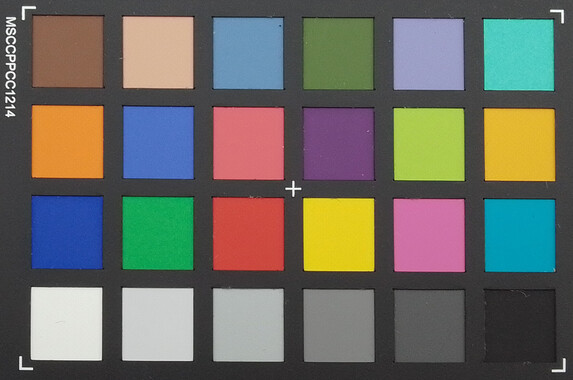
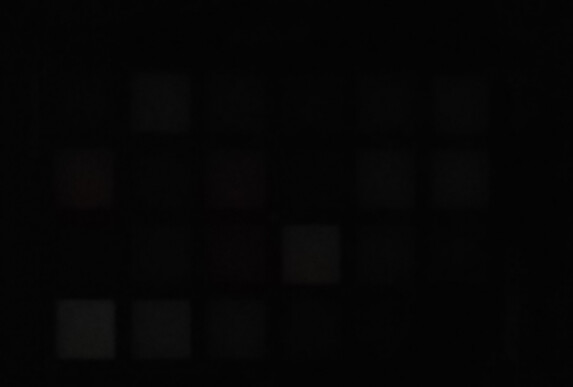
Display - Darker than the predecessor
Resolution and aspect ratio are the same as last year's model, but the IPS screen does not show as bright this time. With 336 cd/m² on average, it is on a low level, even for the price range. The brightness distribution is also relatively uneven.
The contrast ratio and thus the luminosity of the colors on the screen also suffer from the low brightness.
There is a clear color cast in grayscale, colors are displayed reasonably accurately.
| |||||||||||||||||||||||||
Brightness Distribution: 84 %
Center on Battery: 346 cd/m²
Contrast: 865:1 (Black: 0.4 cd/m²)
ΔE ColorChecker Calman: 4.65 | ∀{0.5-29.43 Ø4.78}
ΔE Greyscale Calman: 6 | ∀{0.09-98 Ø5}
94.7% sRGB (Calman 2D)
Gamma: 2.192
CCT: 8306 K
| Motorola Moto E6i IPS, 1560x720, 6.1" | Motorola Moto E6s IPS, 1560x720, 6.1" | Nokia 3.4 IPS, 1560x720, 6.4" | Xiaomi Redmi 9AT IPS LCD , 1600x720, 6.5" | |
|---|---|---|---|---|
| Response Times | 17% | 24% | 9% | |
| Response Time Grey 50% / Grey 80% * (ms) | 60 ? | 64 ? -7% | 46 ? 23% | 55 ? 8% |
| Response Time Black / White * (ms) | 40 ? | 24 ? 40% | 30 ? 25% | 36 ? 10% |
| PWM Frequency (Hz) | 962 ? | |||
| Screen | 34% | 10% | 2% | |
| Brightness middle (cd/m²) | 346 | 488 41% | 440 27% | 374 8% |
| Brightness (cd/m²) | 336 | 481 43% | 417 24% | 345 3% |
| Brightness Distribution (%) | 84 | 95 13% | 91 8% | 85 1% |
| Black Level * (cd/m²) | 0.4 | 0.25 37% | 0.4 -0% | 0.46 -15% |
| Contrast (:1) | 865 | 1952 126% | 1100 27% | 813 -6% |
| Colorchecker dE 2000 * | 4.65 | 5.02 -8% | 4.77 -3% | 3.86 17% |
| Colorchecker dE 2000 max. * | 8.43 | 8.99 -7% | 8.85 -5% | 8.07 4% |
| Greyscale dE 2000 * | 6 | 4.4 27% | 5.7 5% | 5.7 5% |
| Gamma | 2.192 100% | 2.252 98% | 2.156 102% | 2.307 95% |
| CCT | 8306 78% | 7841 83% | 7660 85% | 6932 94% |
| Total Average (Program / Settings) | 26% /
31% | 17% /
13% | 6% /
4% |
* ... smaller is better
Display Response Times
| ↔ Response Time Black to White | ||
|---|---|---|
| 40 ms ... rise ↗ and fall ↘ combined | ↗ 19 ms rise | |
| ↘ 21 ms fall | ||
| The screen shows slow response rates in our tests and will be unsatisfactory for gamers. In comparison, all tested devices range from 0.1 (minimum) to 240 (maximum) ms. » 97 % of all devices are better. This means that the measured response time is worse than the average of all tested devices (20.2 ms). | ||
| ↔ Response Time 50% Grey to 80% Grey | ||
| 60 ms ... rise ↗ and fall ↘ combined | ↗ 35 ms rise | |
| ↘ 25 ms fall | ||
| The screen shows slow response rates in our tests and will be unsatisfactory for gamers. In comparison, all tested devices range from 0.165 (minimum) to 636 (maximum) ms. » 96 % of all devices are better. This means that the measured response time is worse than the average of all tested devices (31.6 ms). | ||
Screen Flickering / PWM (Pulse-Width Modulation)
| Screen flickering / PWM not detected | |||
In comparison: 53 % of all tested devices do not use PWM to dim the display. If PWM was detected, an average of 8111 (minimum: 5 - maximum: 343500) Hz was measured. | |||
Performance, emissions and battery life - new SoC? Well...
The Unisoc SC9863A is an SoC that is also already 3 years old, but it is an improvement compared to the Moto E6s in that it is based on more modern Cortex-A55 cores. At the same time, however, the clock speed is significantly lower than that of the Moto E6i predecessor
How does this affect the performance? The Moto E6i is actually slower than its predecessor and all other comparison devices in our benchmarks. These are obviously not good conditions, even though the differences are rarely noticeable in everyday use
You do not have to deal with excessive casing temperatures in the Moto E6i even under load. The smartphone always stays warm to the touch
The mono speaker sounds quite similar to that of the Moto E6sbut there are even fewer low mids this time and the trebles are strongly emphasized. The sound is best at medium volume. If you connect headphones or speakers via 3.5 mm jack or Bluetooth, the sound is clean.
Of course, it is difficult to accommodate a large battery in a compact smartphone. Nevertheless, the Moto E6i achieves decent runtimes of almost 13:38 hours with its 3000 mAhbattery, which should easily be enough for a day of somewhat intensive use. The 5-watt charger takes its time to recharge the battery, and there is no quick-charge function.
| PCMark for Android - Work 2.0 performance score (sort by value) | |
| Motorola Moto E6i | |
| Motorola Moto E6s | |
| Nokia 3.4 | |
| Xiaomi Redmi 9AT | |
| Average UNISOC SC9863A (4389 - 4694, n=6) | |
| 3DMark | |
| 2560x1440 Sling Shot OpenGL ES 3.0 Unlimited (sort by value) | |
| Motorola Moto E6i | |
| Motorola Moto E6s | |
| Nokia 3.4 | |
| Xiaomi Redmi 9AT | |
| Average UNISOC SC9863A (699 - 766, n=6) | |
| Average of class Smartphone (953 - 22613, n=18, last 2 years) | |
| 2560x1440 Sling Shot OpenGL ES 3.0 Unlimited Graphics (sort by value) | |
| Motorola Moto E6i | |
| Motorola Moto E6s | |
| Nokia 3.4 | |
| Xiaomi Redmi 9AT | |
| Average UNISOC SC9863A (629 - 681, n=6) | |
| Average of class Smartphone (879 - 45492, n=18, last 2 years) | |
| 2560x1440 Sling Shot OpenGL ES 3.0 Unlimited Physics (sort by value) | |
| Motorola Moto E6i | |
| Motorola Moto E6s | |
| Nokia 3.4 | |
| Xiaomi Redmi 9AT | |
| Average UNISOC SC9863A (1107 - 1407, n=6) | |
| Average of class Smartphone (1352 - 8203, n=18, last 2 years) | |
| GFXBench | |
| on screen Aztec Ruins Normal Tier Onscreen (sort by value) | |
| Motorola Moto E6i | |
| Motorola Moto E6s | |
| Nokia 3.4 | |
| Xiaomi Redmi 9AT | |
| Average UNISOC SC9863A (3 - 6.2, n=8) | |
| Average of class Smartphone (6.2 - 166, n=211, last 2 years) | |
| 1920x1080 Aztec Ruins Normal Tier Offscreen (sort by value) | |
| Motorola Moto E6i | |
| Motorola Moto E6s | |
| Nokia 3.4 | |
| Xiaomi Redmi 9AT | |
| Average UNISOC SC9863A (3.2 - 3.4, n=8) | |
| Average of class Smartphone (3.4 - 367, n=211, last 2 years) | |
| on screen Aztec Ruins High Tier Onscreen (sort by value) | |
| Motorola Moto E6i | |
| Motorola Moto E6s | |
| Nokia 3.4 | |
| Xiaomi Redmi 9AT | |
| Average UNISOC SC9863A (1.9 - 3.8, n=8) | |
| Average of class Smartphone (0.85 - 144, n=212, last 2 years) | |
| 2560x1440 Aztec Ruins High Tier Offscreen (sort by value) | |
| Motorola Moto E6i | |
| Motorola Moto E6s | |
| Nokia 3.4 | |
| Xiaomi Redmi 9AT | |
| Average UNISOC SC9863A (1.1 - 1.2, n=7) | |
| Average of class Smartphone (1.2 - 129, n=211, last 2 years) | |
| Motorola Moto E6i | Motorola Moto E6s | Nokia 3.4 | Xiaomi Redmi 9AT | Average 32 GB eMMC Flash | Average of class Smartphone | |
|---|---|---|---|---|---|---|
| AndroBench 3-5 | 117% | 293% | 157% | 108% | 2510% | |
| Sequential Read 256KB (MB/s) | 98.4 | 275 179% | 301.9 207% | 266.4 171% | 242 ? 146% | 2226 ? 2162% |
| Sequential Write 256KB (MB/s) | 90.9 | 103.5 14% | 221.6 144% | 84.2 -7% | 100.5 ? 11% | 1848 ? 1933% |
| Random Read 4KB (MB/s) | 35.7 | 69.4 94% | 123.1 245% | 46.49 30% | 43.1 ? 21% | 295 ? 726% |
| Random Write 4KB (MB/s) | 6.3 | 17.7 181% | 42.5 575% | 33.53 432% | 22.3 ? 254% | 335 ? 5217% |
Temperature
(+) The maximum temperature on the upper side is 39.9 °C / 104 F, compared to the average of 35.2 °C / 95 F, ranging from 21.9 to 247 °C for the class Smartphone.
(+) The bottom heats up to a maximum of 39.9 °C / 104 F, compared to the average of 34 °C / 93 F
(+) In idle usage, the average temperature for the upper side is 26.3 °C / 79 F, compared to the device average of 32.9 °C / 91 F.
Loudspeaker
Motorola Moto E6i audio analysis
(+) | speakers can play relatively loud (82.6 dB)
Bass 100 - 315 Hz
(-) | nearly no bass - on average 36.1% lower than median
(±) | linearity of bass is average (12.4% delta to prev. frequency)
Mids 400 - 2000 Hz
(±) | higher mids - on average 6.7% higher than median
(±) | linearity of mids is average (9% delta to prev. frequency)
Highs 2 - 16 kHz
(±) | higher highs - on average 7.2% higher than median
(±) | linearity of highs is average (10.2% delta to prev. frequency)
Overall 100 - 16.000 Hz
(±) | linearity of overall sound is average (28.8% difference to median)
Compared to same class
» 75% of all tested devices in this class were better, 4% similar, 21% worse
» The best had a delta of 11%, average was 35%, worst was 134%
Compared to all devices tested
» 86% of all tested devices were better, 3% similar, 11% worse
» The best had a delta of 4%, average was 24%, worst was 134%
Motorola Moto E6s audio analysis
(+) | speakers can play relatively loud (82.3 dB)
Bass 100 - 315 Hz
(-) | nearly no bass - on average 66.5% lower than median
(+) | bass is linear (0% delta to prev. frequency)
Mids 400 - 2000 Hz
(-) | nearly no mids - on average 66.5% lower than median
(+) | mids are linear (0% delta to prev. frequency)
Highs 2 - 16 kHz
(-) | nearly no highs - on average 66.5% lower than median
(+) | highs are linear (0% delta to prev. frequency)
Overall 100 - 16.000 Hz
(-) | overall sound is not linear (121.9% difference to median)
Compared to same class
» 91% of all tested devices in this class were better, 7% similar, 2% worse
» The best had a delta of 11%, average was 35%, worst was 134%
Compared to all devices tested
» 97% of all tested devices were better, 2% similar, 1% worse
» The best had a delta of 4%, average was 24%, worst was 134%
Battery life
| Motorola Moto E6i 3000 mAh | Motorola Moto E6s 3000 mAh | Nokia 3.4 4000 mAh | Xiaomi Redmi 9AT 5000 mAh | Average of class Smartphone | |
|---|---|---|---|---|---|
| Battery Runtime | |||||
| WiFi Websurfing (h) | 13.6 | 13.4 -1% | 14.1 4% | 19.1 40% | 19.3 ? 42% |
Pros
Cons
Verdict - Hardly any improvement, even regression
Already last year, the inexpensive and compact Moto E6s was a solid, very affordable smartphone if you like your phone compact. The Motorola Moto E6i manages that again as its successor, but there are some differences because of which you should carefully consider whether the supposedly older model might not even make more sense for you:
For example, the screen of this year's model is darker than that of the predecessor, the back and build quality look a bit plainer, and you even have to accept performance losses despite the supposedly somewhat more modern SoC. Sure, these are minimal and probably hardly noticeable in everyday use, but it is still a bad sign for a successor if it is slower than the previous year's model.
The Moto E6i is a solid, inexpensive phone that primarily convinces with its compact dimensions.
Unfortunately, the Moto E6s is hardly available anymore and also 10 Euros more expensive than its successor, but there are also alternatives from other manufacturers. How does the Moto E6i fare here? It is on class level in most areas, but it can hardly stand out. At the same time, there are few truly compact and lightweight smartphones, so the Moto E6i is worth a look if that is what you are looking for.
Price and availability
The Motorola Moto E6i is available at the time of testing from the manufacturer itself and at some online retailers. Prices start at around 90 Euros, with Amazon (US) currently paying 144.99 Dollars.
Motorola Moto E6i
- 05/24/2021 v7 (old)
Florian Schmitt




